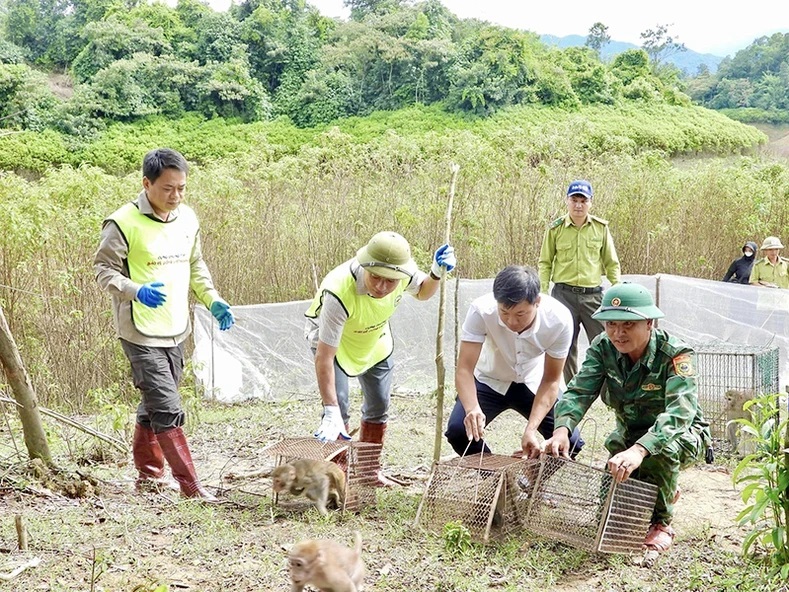In Vietnam, the conservation of endangered, precious, and rare wildlife species is a top priority in biodiversity conservation efforts. This responsibility extends across the entire political system along with society as a whole.

The Save Vietnam’s Wildlife (SVW) Centre, in coordination with the rangers of Cuc Phuong National Park, releases wildlife back into the wild. (Photo: SVW)
The Convention on International Trade in Endangered Species of Wild Fauna and Flora (CITES) was signed in 1973 and came into effect on July 1, 1975. With 184-member countries today, CITES is currently the world’s largest international conservation treaty.
The purpose of CITES is to ensure that international trade in endangered wildlife species does not threaten their survival in the wild. It establishes various levels of protection for more than 34,000 species of animals and plants.
Earth is home to countless species of wildlife. Over billions of years, biodiversity has shaped the planet into a habitat for all living beings, including humans.
However, unsustainable human activities, such as overexploitation of wildlife and natural resources, are destroying global biodiversity. Nearly one-quarter of all species on Earth are facing the risk of extinction within the next few decades.
The collapse of these species will accelerate the disappearance of others, ultimately threatening human survival. World Wildlife Day 2025 highlights the crucial role of wildlife in biodiversity and human life.
In Vietnam, numerous actions to protect and conserve wildlife have been undertaken by government agencies, international organisations, NGOs, the private sector, and the public.
In addition to policy and legal reforms, strengthening law enforcement, and raising awareness, various initiatives play a vital role in promoting biodiversity conservation and sustainable use.
To restore, protect, and sustainably develop endangered, precious, and rare wildlife species in line with the National Biodiversity Strategy to 2030, with a vision to 2050, and to contribute to economic and social development under the green economy model while adapting to climate change, the prime minister issued Decision No. 49/QD-TTg on January 8, 2025. This decision approves the National Programme for the Conservation of Endangered, Precious, and Rare Wildlife Species until 2030, with a vision to 2050.
The programme aims to effectively conserve endangered, precious, and rare wildlife species by improving the population status of at least 10 species, protecting and restoring their habitats, increasing the number of species bred for conservation and reintroduced into the wild, and ensuring that at least three species are successfully bred and reintroduced by 2030. The goal is to have 100% of endangered, precious, and rare wildlife species managed and monitored within nature reserves, high-biodiversity areas, and conservation facilities.

Vu Quang National Park, in collaboration with the Ha Tinh Forest Protection Department, releases wildlife back into its natural habitat. (Photo: Nguyen Son)
Policies and legislation on endangered, precious, and rare wildlife conservation will continue to be improved, along with enhanced organisational capacity and management to better control, prevent, and mitigate threats to these species and their habitats.
The government has directed authorities to strengthen cooperation among law enforcement agencies in combating illegal activities related to endangered wildlife species. This includes preventing and addressing illegal hunting, transportation, trade, possession, advertising, and consumption of wildlife and their products, as well as the use of hunting tools, traps, and firearms.
Measures include developing coordination mechanisms, information-sharing systems, and hotlines to report wildlife crimes; effectively implementing the National Plan to Combat Biodiversity Crime until 2030, with a vision to 2050; and publicly disclosing information on biodiversity-related offenses.
Additionally, emergency action plans will be developed to protect species at high risk of extinction, particularly mammals, birds, terrestrial turtles, and freshwater turtles.
From now until 2030, the government will focus on large-scale projects, including conducting surveys and assessments to establish a database of endangered, precious, and rare wildlife species and developing and implementing pilot conservation models for these species. The government also aims to create breeding and reintroduction programmes to restore wild populations of critically endangered species while establishing emergency action plans to conserve highly endangered species.
By prioritising these efforts, Vietnam aims to ensure the long-term survival of its wildlife and contribute to global biodiversity conservation.
Dung Minh
















